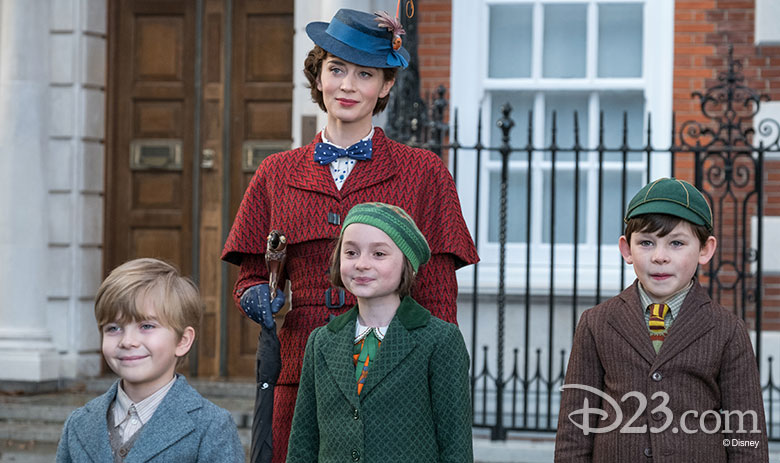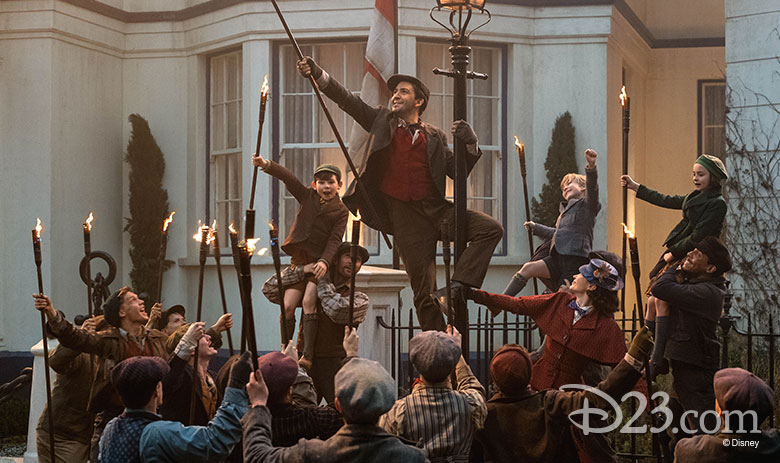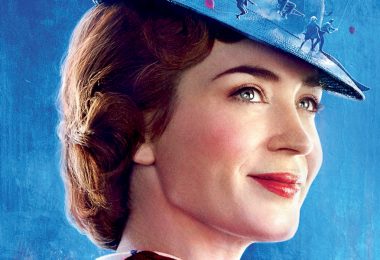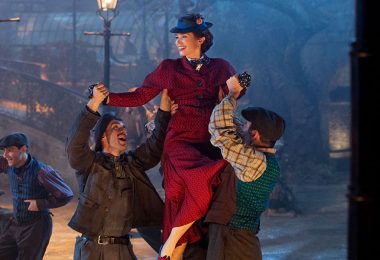By Bruce Steele
There can be only one Mary Poppins. She is, says Emily Blunt, “a completely singular character.” But on the London set of Mary Poppins Returns, in which Blunt brings the magical nanny back to the screen, you very quickly learn that duplication is the rule.
As costume designer Sandy Powell tours a building at Shepperton Studios that’s jam-packed with costumes, props and concept art from the movie that’s currently being filmed on nearby soundstages, she explains why there are no vintage costumes in the movie, set in 1930s London.
“Everything has to be 100 percent made,” she says, “because we make multiples.”

Standing next to mannequins dressed in the costumes of the family of Michael Banks, who has grown up and become a single father of three in the 20-plus years since the events of the 1964 Mary Poppins, Powell relates that making the kids’ clothes was a particular challenge.
“Things happen to kids,” she says, and the costume department has to be ready to step in with a fresh costume immediately, so filming isn’t held up by a wardrobe malfunction. “Then they get muddy, and we have to have multiples of that [the muddy clothes]. And then each of these kids has a photo double, an acting double and a stunt double, and each of those kids has to have the same number of multiples.”
She consults with her assistant, Charlotte Law, who quickly provides the totals: 15 copies of one child’s outfit, 10 each for the other two. And that’s just for one scene.
“And they keep growing,” Powell adds, “so we have to switch them out with longer-length trousers.”

Another mannequin wears Mary Poppins’ familiar dark blue coat and her newly redesigned hat, no longer adorned with flowers. “I don’t see Mary Poppins as being very floral,” Powell says. Instead there’s a small robin on one end of her hat pin. Powell’s team had seven copies of this hat at the ready, along with seven robin-topped pins.
When Poppins herself appears in the form of Emily Blunt, taking a break in the filming, she is wearing one of those seven hats along with a coat in a rich red hue, rather than the usual dark blue. Today’s scene is the song “Trip a Little Light Fantastic,” a complicated musical number featuring Lin-Manuel Miranda as Jack, a lamplighter who was a protégé to Mary’s now-departed friend Bert. Jack is joined by about 50 of his fellow lamplighters for a dance extravaganza set in an abandoned park at night, so Powell designed a red coat for Mary that would pop better in lower light. It’s paired with a skirt generous enough that “when she spins, you get the full Ginger Rogers effect,” the designer says.
By this point, many weeks into the filming, Blunt is comfortable in her iconic role, attributing her ease to director Rob Marshall, with whom she worked on Into the Woods. She was “terribly excited” to be offered the part, she says, and accepted despite some “trepidations about taking on such an iconic role that had been played by such an iconic actress,” Julie Andrews.

“But I think Rob’s greatest quality is making you feel like the impossible is possible,” Blunt says.
For the filmmaking team, that meant having the courage to leave the first Mary Poppins behind them. When production designer John Myhre visits the Shepperton building housing the display of costumes and props, he explains: “The first thing Rob said to me when he invited me on the project was that this was our movie. And while we’re certainly giving a nod to the original, we have a different story, and it’s a more contemporary audience [that will see it].”
For example, the talking parrot head on Mary’s umbrella handle is more elaborate than in the 1964 movie. “We went through many, many passes,” says Myhre, who supervised prop construction as well as designing all the sets. “Rob wanted it to feel more real.”
The final parrot head – and yes, there are many copies of the umbrella, as well—is made both to look as much like a parrot as possible and (in some versions) to contain the mechanics necessary to have it speak. The team discussed using computer effects to create the talking parrot “in post,” after the filming was complete, Myhre says, but decided to stick to animatronics because “the kids are going to have a much better time talking to a parrot head umbrella that can actually talk to them” during the filming.
In the prop workshop nearby on the Shepperton lot, prop supervisor Nick Richardson explains the many steps necessary to make the umbrella handle, with the parrot’s many iterations laid out on a table in front of him.
First an artist needed to carve a sculpture of the head—approved by Myhre and Marshall— then the sculpt was scanned in minute detail to create a computer model that could be reproduced by a 3D printer. The print, made in two halves, was cleaned up by hand and used to create a mold from which the final parrot heads were cast in resin. The heads were then hand-painted, copper plating and other details added, and the brass highlights were then etched, cut out, and lovingly attached.
And then they did it again. And again. Until they had the number of Poppins umbrellas necessary for filming.
Ditto Mary’s carpet bag, several copies of which are displayed on another table in the prop department: The full bag with polka-dot lining. The bag with a hole in the bottom for passing through larger objects. And so on.
“On all these movie props, you need many, many, many, many,” Myhre says. “You can’t just have one.”
Myhre also reveals something else that’s duplicated in today’s filming—something Disney’s most loyal fans might notice in the final movie that other viewers are likely to overlook.

On the set where the lamplighter musical number is being filmed, in one of the 10 soundstages at Shepperton filled with Poppins sets, Myhre says, “I put in six hidden Mickeys.” Both he and Marshall are big fans of Disneyland, he explains.
It just goes to show, even the filmmakers tasked with bringing Mary Poppins back to the screen after 54 years are, in their hearts, aspiring Disney Imagineers.





